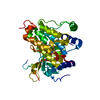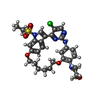[English] 日本語
 Yorodumi
Yorodumi- PDB-7vra: The crystal structure of EGFR T790M/C797S with the inhibitor HC5476 -
+ Open data
Open data
- Basic information
Basic information
| Entry | Database: PDB / ID: 7vra | ||||||
|---|---|---|---|---|---|---|---|
| Title | The crystal structure of EGFR T790M/C797S with the inhibitor HC5476 | ||||||
 Components Components | Epidermal growth factor receptor | ||||||
 Keywords Keywords | TRANSFERASE/TRANSFERASE INHIBITOR / EGFR / inhibitor / complex / TRANSFERASE / TRANSFERASE-TRANSFERASE INHIBITOR complex | ||||||
| Function / homology |  Function and homology information Function and homology informationmultivesicular body, internal vesicle lumen / negative regulation of cardiocyte differentiation / Shc-EGFR complex / positive regulation of protein kinase C signaling / Inhibition of Signaling by Overexpressed EGFR / epidermal growth factor receptor activity / EGFR interacts with phospholipase C-gamma / regulation of peptidyl-tyrosine phosphorylation / epidermal growth factor binding / response to UV-A ...multivesicular body, internal vesicle lumen / negative regulation of cardiocyte differentiation / Shc-EGFR complex / positive regulation of protein kinase C signaling / Inhibition of Signaling by Overexpressed EGFR / epidermal growth factor receptor activity / EGFR interacts with phospholipase C-gamma / regulation of peptidyl-tyrosine phosphorylation / epidermal growth factor binding / response to UV-A / PLCG1 events in ERBB2 signaling / ERBB2-EGFR signaling pathway / morphogenesis of an epithelial fold / PTK6 promotes HIF1A stabilization / ERBB2 Activates PTK6 Signaling / digestive tract morphogenesis / Signaling by EGFR / intracellular vesicle / eyelid development in camera-type eye / negative regulation of epidermal growth factor receptor signaling pathway / cerebral cortex cell migration / protein insertion into membrane / ERBB2 Regulates Cell Motility / protein tyrosine kinase activator activity / Respiratory syncytial virus (RSV) attachment and entry / Signaling by ERBB4 / PI3K events in ERBB2 signaling / positive regulation of phosphorylation / positive regulation of peptidyl-serine phosphorylation / Estrogen-dependent nuclear events downstream of ESR-membrane signaling / hair follicle development / MAP kinase kinase kinase activity / GAB1 signalosome / positive regulation of G1/S transition of mitotic cell cycle / embryonic placenta development / salivary gland morphogenesis / Signaling by ERBB2 / GRB2 events in EGFR signaling / TFAP2 (AP-2) family regulates transcription of growth factors and their receptors / SHC1 events in EGFR signaling / transmembrane receptor protein tyrosine kinase activity / EGFR Transactivation by Gastrin / GRB2 events in ERBB2 signaling / SHC1 events in ERBB2 signaling / ossification / NOTCH3 Activation and Transmission of Signal to the Nucleus / basal plasma membrane / positive regulation of DNA repair / cellular response to epidermal growth factor stimulus / EGFR downregulation / positive regulation of DNA replication / epithelial cell proliferation / Signal transduction by L1 / positive regulation of epithelial cell proliferation / positive regulation of protein localization to plasma membrane / cellular response to amino acid stimulus / phosphatidylinositol 3-kinase/protein kinase B signal transduction / cellular response to estradiol stimulus / clathrin-coated endocytic vesicle membrane / Signaling by ERBB2 TMD/JMD mutants / Constitutive Signaling by EGFRvIII / Downregulation of ERBB2 signaling / cell-cell adhesion / receptor protein-tyrosine kinase / Signaling by ERBB2 ECD mutants / negative regulation of protein catabolic process / Signaling by ERBB2 KD Mutants / positive regulation of miRNA transcription / kinase binding / ruffle membrane / epidermal growth factor receptor signaling pathway / positive regulation of protein phosphorylation / cell morphogenesis / neuron differentiation / positive regulation of fibroblast proliferation / HCMV Early Events / Constitutive Signaling by Aberrant PI3K in Cancer / actin filament binding / Cargo recognition for clathrin-mediated endocytosis / cell junction / transmembrane signaling receptor activity / Constitutive Signaling by Ligand-Responsive EGFR Cancer Variants / Clathrin-mediated endocytosis / positive regulation of canonical Wnt signaling pathway / PIP3 activates AKT signaling / virus receptor activity / ATPase binding / RAF/MAP kinase cascade / PI5P, PP2A and IER3 Regulate PI3K/AKT Signaling / positive regulation of cell growth / double-stranded DNA binding / protein tyrosine kinase activity / early endosome membrane / protein phosphatase binding / nuclear membrane / basolateral plasma membrane / learning or memory / Extra-nuclear estrogen signaling / cell surface receptor signaling pathway / endosome membrane Similarity search - Function | ||||||
| Biological species |  Homo sapiens (human) Homo sapiens (human) | ||||||
| Method |  X-RAY DIFFRACTION / X-RAY DIFFRACTION /  SYNCHROTRON / SYNCHROTRON /  MOLECULAR REPLACEMENT / Resolution: 2.41 Å MOLECULAR REPLACEMENT / Resolution: 2.41 Å | ||||||
 Authors Authors | Zhu, S.J. | ||||||
| Funding support |  China, 1items China, 1items
| ||||||
 Citation Citation |  Journal: J.Med.Chem. / Year: 2022 Journal: J.Med.Chem. / Year: 2022Title: Conformational Constrained 4-(1-Sulfonyl-3-indol)yl-2-phenylaminopyrimidine Derivatives as New Fourth-Generation Epidermal Growth Factor Receptor Inhibitors Targeting T790M/C797S Mutations. Authors: Chen, H. / Lai, M. / Zhang, T. / Chen, Y. / Tong, L. / Zhu, S. / Zhou, Y. / Ren, X. / Ding, J. / Xie, H. / Lu, X. / Ding, K. | ||||||
| History |
|
- Structure visualization
Structure visualization
| Structure viewer | Molecule:  Molmil Molmil Jmol/JSmol Jmol/JSmol |
|---|
- Downloads & links
Downloads & links
- Download
Download
| PDBx/mmCIF format |  7vra.cif.gz 7vra.cif.gz | 76.5 KB | Display |  PDBx/mmCIF format PDBx/mmCIF format |
|---|---|---|---|---|
| PDB format |  pdb7vra.ent.gz pdb7vra.ent.gz | 54.1 KB | Display |  PDB format PDB format |
| PDBx/mmJSON format |  7vra.json.gz 7vra.json.gz | Tree view |  PDBx/mmJSON format PDBx/mmJSON format | |
| Others |  Other downloads Other downloads |
-Validation report
| Summary document |  7vra_validation.pdf.gz 7vra_validation.pdf.gz | 815.5 KB | Display |  wwPDB validaton report wwPDB validaton report |
|---|---|---|---|---|
| Full document |  7vra_full_validation.pdf.gz 7vra_full_validation.pdf.gz | 819.2 KB | Display | |
| Data in XML |  7vra_validation.xml.gz 7vra_validation.xml.gz | 13.2 KB | Display | |
| Data in CIF |  7vra_validation.cif.gz 7vra_validation.cif.gz | 17 KB | Display | |
| Arichive directory |  https://data.pdbj.org/pub/pdb/validation_reports/vr/7vra https://data.pdbj.org/pub/pdb/validation_reports/vr/7vra ftp://data.pdbj.org/pub/pdb/validation_reports/vr/7vra ftp://data.pdbj.org/pub/pdb/validation_reports/vr/7vra | HTTPS FTP |
-Related structure data
| Related structure data |  7vreC  6jrjS S: Starting model for refinement C: citing same article ( |
|---|---|
| Similar structure data | Similarity search - Function & homology  F&H Search F&H Search |
- Links
Links
- Assembly
Assembly
| Deposited unit | 
| ||||||||
|---|---|---|---|---|---|---|---|---|---|
| 1 |
| ||||||||
| Unit cell |
|
- Components
Components
| #1: Protein | Mass: 37460.363 Da / Num. of mol.: 1 / Mutation: T790M, C797S Source method: isolated from a genetically manipulated source Source: (gene. exp.)  Homo sapiens (human) / Gene: EGFR, ERBB, ERBB1, HER1 / Production host: Homo sapiens (human) / Gene: EGFR, ERBB, ERBB1, HER1 / Production host:  References: UniProt: P00533, receptor protein-tyrosine kinase |
|---|---|
| #2: Chemical | ChemComp-I0A / |
| #3: Water | ChemComp-HOH / |
| Has ligand of interest | Y |
-Experimental details
-Experiment
| Experiment | Method:  X-RAY DIFFRACTION / Number of used crystals: 1 X-RAY DIFFRACTION / Number of used crystals: 1 |
|---|
- Sample preparation
Sample preparation
| Crystal | Density Matthews: 3.39 Å3/Da / Density % sol: 63.71 % |
|---|---|
| Crystal grow | Temperature: 293 K / Method: vapor diffusion, hanging drop / pH: 6.2 Details: 0.05M CaCl2, 0.1M B-Tris pH 6.2, 24% PEG 550MME, 5mM TCEP |
-Data collection
| Diffraction | Mean temperature: 100 K / Serial crystal experiment: N |
|---|---|
| Diffraction source | Source:  SYNCHROTRON / Site: SYNCHROTRON / Site:  SSRF SSRF  / Beamline: BL19U1 / Wavelength: 0.987 Å / Beamline: BL19U1 / Wavelength: 0.987 Å |
| Detector | Type: DECTRIS PILATUS 300K / Detector: PIXEL / Date: Nov 28, 2020 |
| Radiation | Protocol: SINGLE WAVELENGTH / Monochromatic (M) / Laue (L): M / Scattering type: x-ray |
| Radiation wavelength | Wavelength: 0.987 Å / Relative weight: 1 |
| Reflection | Resolution: 2.41→50 Å / Num. obs: 19296 / % possible obs: 100 % / Redundancy: 19.3 % / Rpim(I) all: 0.029 / Net I/σ(I): 41 |
| Reflection shell | Resolution: 2.41→2.5 Å / Num. unique obs: 19296 / Rpim(I) all: 0.479 |
- Processing
Processing
| Software |
| ||||||||||||||||||||||||||||||||||||||||||||||||||||||||
|---|---|---|---|---|---|---|---|---|---|---|---|---|---|---|---|---|---|---|---|---|---|---|---|---|---|---|---|---|---|---|---|---|---|---|---|---|---|---|---|---|---|---|---|---|---|---|---|---|---|---|---|---|---|---|---|---|---|
| Refinement | Method to determine structure:  MOLECULAR REPLACEMENT MOLECULAR REPLACEMENTStarting model: 6JRJ Resolution: 2.41→22.37 Å / SU ML: 0.35 / Cross valid method: THROUGHOUT / σ(F): 1.34 / Phase error: 31.2 / Stereochemistry target values: ML
| ||||||||||||||||||||||||||||||||||||||||||||||||||||||||
| Solvent computation | Shrinkage radii: 0.9 Å / VDW probe radii: 1.11 Å / Solvent model: FLAT BULK SOLVENT MODEL | ||||||||||||||||||||||||||||||||||||||||||||||||||||||||
| Displacement parameters | Biso max: 138.03 Å2 / Biso mean: 66.3609 Å2 / Biso min: 38.38 Å2 | ||||||||||||||||||||||||||||||||||||||||||||||||||||||||
| Refinement step | Cycle: final / Resolution: 2.41→22.37 Å
| ||||||||||||||||||||||||||||||||||||||||||||||||||||||||
| LS refinement shell | Refine-ID: X-RAY DIFFRACTION / Rfactor Rfree error: 0 / Total num. of bins used: 7
|
 Movie
Movie Controller
Controller


 PDBj
PDBj















